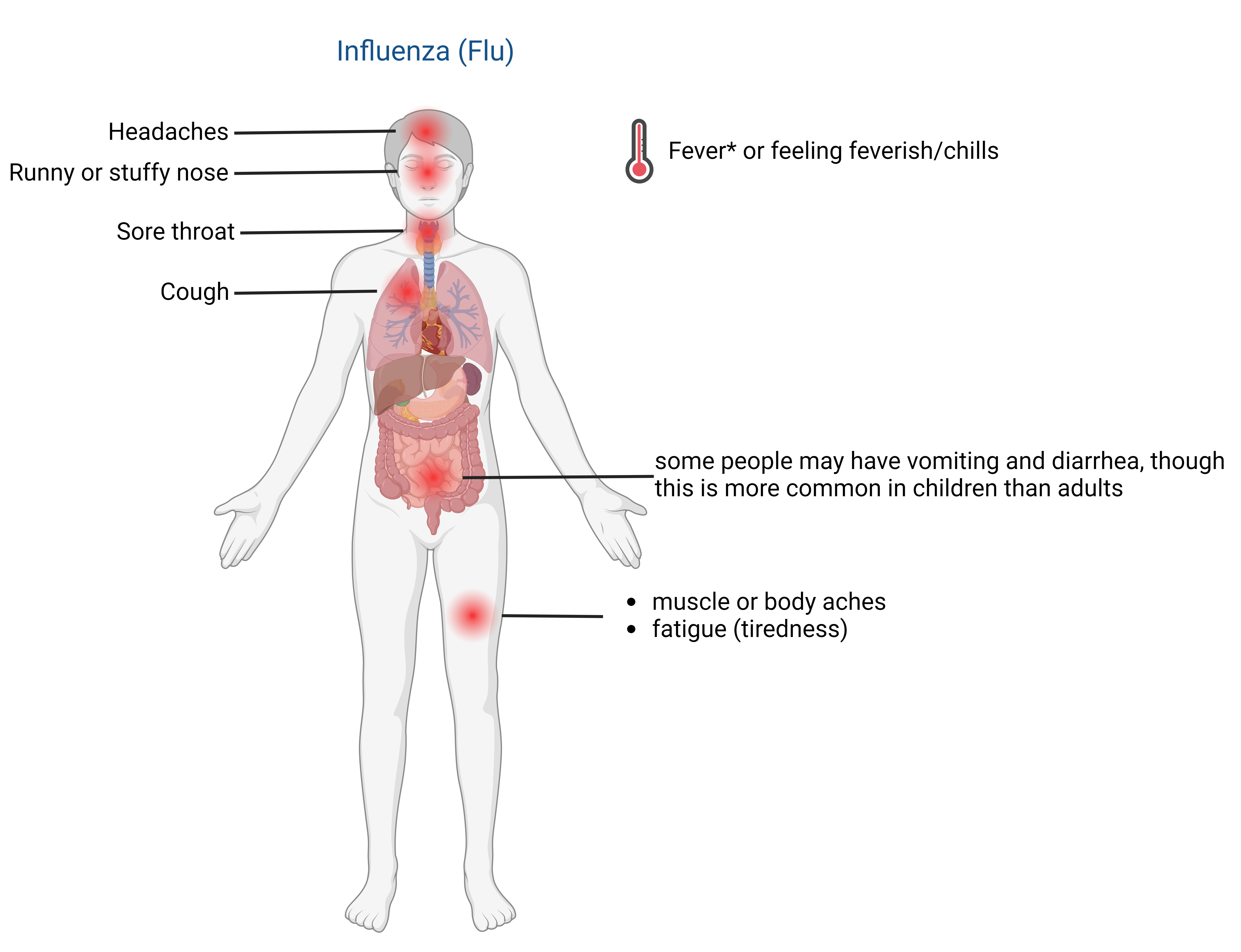import { virusInfoOrUndefinedF } from "/_js/functions.js"
import { availableVirusInfoF } from "/_js/functions.js"
import { availableToolsF } from "/_js/functions.js"
import { virusOfInterestF } from "/_js/functions.js"

Influenza, commonly referred to as the flu, has the potential to induce a range of symptoms, spanning from mild discomfort to severe illness, and in some instances, fatality. Typically, flu symptoms manifest abruptly.
Not all individuals experiencing the flu will necessarily have a fever.

Influenza (Flu) primarily spreads through respiratory droplets released when infected individuals cough, sneeze, or engage in conversation.
Additionally, it can be contracted by touching contaminated surfaces and subsequently touching one’s face.
The highest level of contagion among individuals with the flu typically occurs during the initial 3-4 days of their illness.
In some cases, otherwise healthy adults can begin transmitting the virus to others as early as one day before they start showing symptoms, and this contagious period may persist for up to five to seven days after the onset of illness.
It’s important to note that certain individuals, particularly young children and those with weakened immune systems, may remain contagious for an extended duration.
Seasonal flu

Above, influenza virus detection within Europe was shown using the data obtained from the World Health Organisation (WHO) and Global Influenza Surveillance & Response System (GIRS). For more information about the global virus circulation, please visit this link.
Each year, global populations experience annual flu outbreaks, with seasonal flu epidemics recurring annually. An exception was seen during the 2021 season due to the infection control measurements during the COVID-19 pandemic.
Influenza results in between 3 and 5 million serious cases and 250,000 to 500,000 deaths per year in the world (WHO).
H1N1 flu, also known as swine flu, caused a 2009-2010 pandemic with approximately 284,400 global deaths. Although the pandemic officially ended in 2010, the H1N1pdm09 strain remains part of seasonal flu infections.
While two influenza B virus lineages emerged in the 1970s and have been co-circulated since 2001, B/Yamagata-lineage circulation has not been confirmed since March 2020.
Pandemic flu

A flu pandemic is a worldwide emergence of a novel influenza viruses in humans. Over the last century, we have witnessed the occurrence of four influenza pandemics. Therefore, the occurrence of another pandemic is inevitable.
Please visit this link for more information about seaonal and pandemic influenza (flu).
If you are interested in assessing testing capabilities for a particular influenza strain, kindly get in touch with us through info@virusbankplatform.be to inquire about the availability of our toolbox.’
Bird flu, also known as avian influenza or AI, is a highly contagious viral disease that affects a variety of bird species used in food production, as well as ornamental and wild birds. Avian influenza viruses induce two distinct forms of illness:
Highly Pathogenic Avian Influenza (HPAI): This results from extremely virulent viruses and leads to a . high mortality rate among affected birds.
Low Pathogenic Avian Influenza (LPAI): This is caused by viruses associated with milder respiratory symptoms, reduced egg production, and a moderate increase in mortality.
The presence of avian flu poses a significant threat to the poultry industry, resulting in substantial economic consequences. Notably, only viruses of subtypes H5 and H7 have the potential to evolve into highly pathogenic forms.
Additionally, certain avian influenza viruses are zoonotic, meaning they can infect humans.

The virus is transmitted between animals, directly via saliva, nasal secretions, and feces of infected animals, or indirectly, through exposure to contaminated food, water, agricultural equipment, etc..
Trade, transport of poultry, migrations of wild birds are equally means of longer-distance transmission
Zoonotic transmission usually occurs during local farming, animal husbandry in industrial settings, i.e. direct or indirect contact during animal breeding, farming, management etc. or in animal markets in which animals are handled, especially without proper protection or care.
A very large number of wild birds have tested positive for highly pathogenic avian influenza; the infectious pressure in the wild is thereby high. The number of infections in the poultry sector is not negligible (38 holdings since September 1, 2022, including 17 professional farms, 20 private owners and 1 zoologic park). Ferrets were also positively detected with the virus at a private keeper where an outbreak in chickens and ducks was detected. Fifteen wild foxes and three wild polecats were also found positive. This underlines the very high level of vigilance and biosecurity needed in order to avoid the introduction of the virus into its facilities.
(info from Sciensano, https://tinyurl.com/yo362qhd)
If you are interested in assessing testing capabilities for a particular avian influenza strain, kindly get in touch with us through info@virusbankplatform.be to inquire about the availability of our toolbox.’
